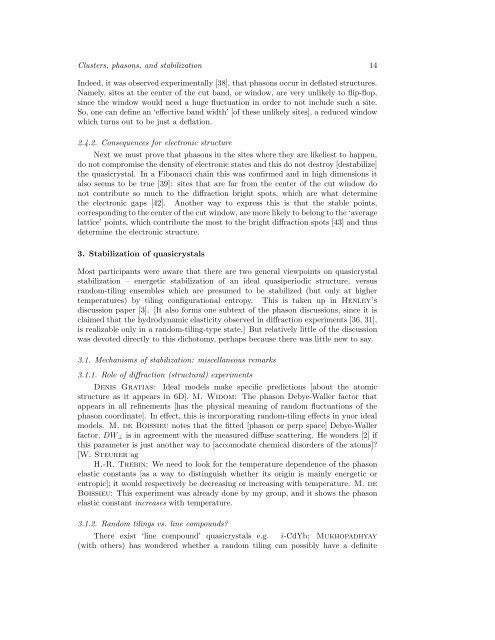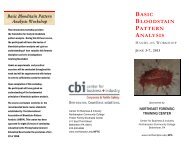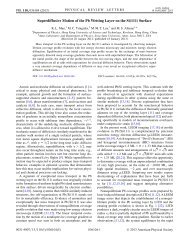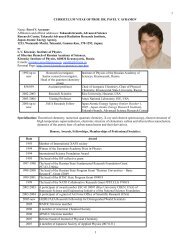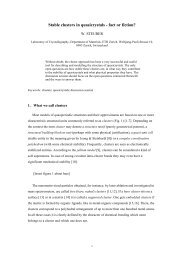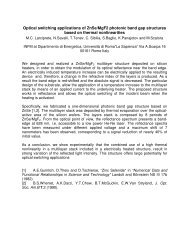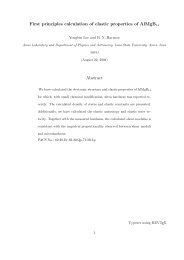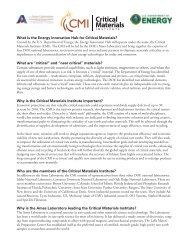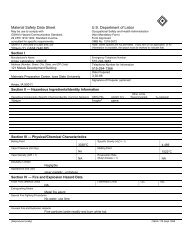Discussion on clusters, phasons, and quasicrystal stabilization
Discussion on clusters, phasons, and quasicrystal stabilization
Discussion on clusters, phasons, and quasicrystal stabilization
You also want an ePaper? Increase the reach of your titles
YUMPU automatically turns print PDFs into web optimized ePapers that Google loves.
Clusters, phas<strong>on</strong>s, <strong>and</strong> stabilizati<strong>on</strong> 14Indeed, it was observed experimentally [38], that phas<strong>on</strong>s occur in deflated structures.Namely, sites at the center of the cut b<strong>and</strong>, or window, are very unlikely to flip-flop,since the window would need a huge fluctuati<strong>on</strong> in order to not include such a site.So, <strong>on</strong>e can define an ‘effective b<strong>and</strong> width’ [of these unlikely sites], a reduced windowwhich turns out to be just a deflati<strong>on</strong>.2.4.2. C<strong>on</strong>sequences for electr<strong>on</strong>ic structureNext we must prove that phas<strong>on</strong>s in the sites where they are likeliest to happen,do not compromise the density of electr<strong>on</strong>ic states <strong>and</strong> this do not destroy [destabilize]the <strong>quasicrystal</strong>. In a Fib<strong>on</strong>acci chain this was c<strong>on</strong>firmed <strong>and</strong> in high dimensi<strong>on</strong>s italso seems to be true [39]: sites that are far from the center of the cut window d<strong>on</strong>ot c<strong>on</strong>tribute so much to the diffracti<strong>on</strong> bright spots, which are what determinethe electr<strong>on</strong>ic gaps [42]. Another way to express this is that the stable points,corresp<strong>on</strong>ding to the center of the cut window, are more likely to bel<strong>on</strong>g to the ‘averagelattice’ points, which c<strong>on</strong>tribute the most to the bright diffracti<strong>on</strong> spots [43] <strong>and</strong> thusdetermine the electr<strong>on</strong>ic structure.3. Stabilizati<strong>on</strong> of <strong>quasicrystal</strong>sMost participants were aware that there are two general viewpoints <strong>on</strong> <strong>quasicrystal</strong>stabilizati<strong>on</strong> – energetic stabilizati<strong>on</strong> of an ideal quasiperiodic structure, versusr<strong>and</strong>om-tiling ensembles which are presumed to be stabilized (but <strong>on</strong>ly at highertemperatures) by tiling c<strong>on</strong>figurati<strong>on</strong>al entropy. This is taken up in Henley’sdiscussi<strong>on</strong> paper [3]. [It also forms <strong>on</strong>e subtext of the phas<strong>on</strong> discussi<strong>on</strong>s, since it isclaimed that the hydrodynamic elasticity observed in diffracti<strong>on</strong> experiments [36, 31],is realizable <strong>on</strong>ly in a r<strong>and</strong>om-tiling-type state.] But relatively little of the discussi<strong>on</strong>was devoted directly to this dichotomy, perhaps because there was little new to say.3.1. Mechanisms of stabilizati<strong>on</strong>: miscellaneous remarks3.1.1. Role of diffracti<strong>on</strong> (structural) experimentsDenis Gratias: Ideal models make specific predicti<strong>on</strong>s [about the atomicstructure as it appears in 6D]. M. Widom: The phas<strong>on</strong> Debye-Waller factor thatappears in all refinements [has the physical meaning of r<strong>and</strong>om fluctuati<strong>on</strong>s of thephas<strong>on</strong> coordinate]. In effect, this is incorporating r<strong>and</strong>om-tiling effects in yuor idealmodels. M. de Boissieu notes that the fitted [phas<strong>on</strong> or perp space] Debye-Wallerfactor, DW ⊥ is in agreement with the measured diffuse scattering. He w<strong>on</strong>ders [2] ifthis parameter is just another way to [accomodate chemical disorders of the atoms]?[W. Steurer agH.-R. Trebin: We need to look for the temperature dependence of the phas<strong>on</strong>elastic c<strong>on</strong>stants [as a way to distinguish whether its origin is mainly energetic orentropic]; it would respectively be decreasing or increasing with temperature. M. deBoissieu: This experiment was already d<strong>on</strong>e by my group, <strong>and</strong> it shows the phas<strong>on</strong>elastic c<strong>on</strong>stant increases with temperature.3.1.2. R<strong>and</strong>om tilings vs. line compounds?There exist ‘line compound’ <strong>quasicrystal</strong>s e.g. i-CdYb; Mukhopadhyay(with others) has w<strong>on</strong>dered whether a r<strong>and</strong>om tiling can possibly have a definite


